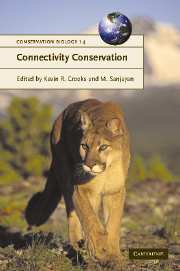Book contents
- Frontmatter
- Contents
- List of contributors
- Acknowledgements
- 1 Connectivity conservation: maintaining connections for nature
- PART I Approaches to connectivity research
- PART II Assessing connectivity
- PART III Challenges and implementation of connectivity conservation
- Introduction: Don't fence me in
- 18 Hyperconnectivity, invasive species, and the breakdown of barriers to dispersal
- 19 Disease and connectivity
- 20 Maintaining and restoring connectivity in landscapes fragmented by roads
- 21 Where to draw the line: integrating feasibility into connectivity planning
- 22 South Coast Missing Linkages: restoring connectivity to wildlands in the largest metropolitan area in the USA
- 23 Incorporating connectivity into broad-scale conservation planning
- 24 Escaping the minimalist trap: design and implementation of large-scale biodiversity corridors
- 25 The role of connectivity in Australian conservation
- 26 The future of connectivity conservation
- Index
- References
26 - The future of connectivity conservation
Published online by Cambridge University Press: 24 May 2010
- Frontmatter
- Contents
- List of contributors
- Acknowledgements
- 1 Connectivity conservation: maintaining connections for nature
- PART I Approaches to connectivity research
- PART II Assessing connectivity
- PART III Challenges and implementation of connectivity conservation
- Introduction: Don't fence me in
- 18 Hyperconnectivity, invasive species, and the breakdown of barriers to dispersal
- 19 Disease and connectivity
- 20 Maintaining and restoring connectivity in landscapes fragmented by roads
- 21 Where to draw the line: integrating feasibility into connectivity planning
- 22 South Coast Missing Linkages: restoring connectivity to wildlands in the largest metropolitan area in the USA
- 23 Incorporating connectivity into broad-scale conservation planning
- 24 Escaping the minimalist trap: design and implementation of large-scale biodiversity corridors
- 25 The role of connectivity in Australian conservation
- 26 The future of connectivity conservation
- Index
- References
Summary
The present threat to Earth's biodiversity from the human enterprise is unprecedented in historic time. Understanding the consequences of environmental change, and developing effective strategies to maintain plant and animal species and the ecological processes on which all of life hinges, present enormous challenges. The growing awareness of environmental change has been mirrored, albeit with a lag, by a shift in focus of scientific endeavors in the ecological sciences. The last three decades have seen strong growth in disciplines that emphasize the importance of using scientific knowledge and skills to address threats to the future of ecosystems throughout the world.
Conservation biology emerged in the 1980s as a “mission-oriented” crisis discipline (Soulé and Wilcox 1980; Soulé 1985). It was to be a “new rallying point for biologists wishing to pool their knowledge and techniques to solve problems” (Soulé and Wilcox 1980). Rapid growth in this field has been accompanied by new journals, such as Animal Conservation, Biodiversity and Conservation, Conservation Biology, Ecological Applications, Ecology and Society, and Pacific Conservation Biology, in which setting out the conservation implications of the published research is regarded as a necessary and important part of the contribution. Likewise, rapid growth in the discipline of landscape ecology has been based on the premise that conceptual advances and empirical studies of the ways in which spatial pattern affects ecological processes will deliver insights for improved land management (Forman 1995; Turner et al. 2001; Wu and Hobbs 2002).
- Type
- Chapter
- Information
- Connectivity Conservation , pp. 676 - 694Publisher: Cambridge University PressPrint publication year: 2006
References
- 14
- Cited by



